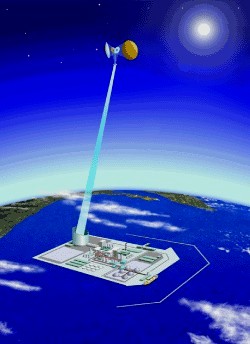 In a development that brings space-based power generation systems a step closer to reality, researchers from the Japan Aerospace Exploration Agency (JAXA) and the Osaka University Institute of Laser Engineering have developed groundbreaking new technology for converting sunlight into laser beams.
In a development that brings space-based power generation systems a step closer to reality, researchers from the Japan Aerospace Exploration Agency (JAXA) and the Osaka University Institute of Laser Engineering have developed groundbreaking new technology for converting sunlight into laser beams.
Relying on plates made from a special ceramic material containing chromium (which absorbs the sunlight) and neodymium (which efficiently converts sunlight to laser light), the newly developed lasers demonstrated an impressive 42% solar-to-laser energy conversion efficiency, outperforming previous technology by a factor of four.
The researchers say the new laser technology will play a key role in JAXA's "Space Solar Power Systems" (SSPS) project, which aims to put space-based power systems in orbit by the year 2030. By mounting the system on a satellite in stationary orbit 36,000 km (22,400 mi.) above the equator, sunlight would be collected and converted into a powerful laser beam, which would then be aimed at a terrestrial power station and used to generate electricity or produce hydrogen.
 Unlike earthbound solar power stations, which are subject to night-time darkness and cloudy conditions, JAXA's SSPS will be able to make use of solar energy 24 hours a day. With slight improvements in the solar-to-laser conversion efficiency and by incorporating solar collectors measuring 100 to 200 meters long, a single satellite will be able to match the output of a 1-gigawatt nuclear power plant, the researchers say. One can only hope these lasers never fall into the wrong hands.
Unlike earthbound solar power stations, which are subject to night-time darkness and cloudy conditions, JAXA's SSPS will be able to make use of solar energy 24 hours a day. With slight improvements in the solar-to-laser conversion efficiency and by incorporating solar collectors measuring 100 to 200 meters long, a single satellite will be able to match the output of a 1-gigawatt nuclear power plant, the researchers say. One can only hope these lasers never fall into the wrong hands.
The results of the research were announced at a meeting of the Japan Society of Applied Physics that began on September 4 in Sapporo.
[Source: Asahi]

Riven
Reminds me of good old Isaac Asimov...
[]I wonder, will they build the MULTIVAC to?
JW
Does anyone else remember playing Sim City 2000 and what happens when the laser got out of allignment and started scorching the city?
[]e
Multivac? Isn't that Google?
[]CowboyDan
I see a couple issues with this idea.
First, what would happen to the clouds that get in the way of the laser?
Second, the cost of putting any satellite into geosynchronous orbit is pretty high, like in the 100's of millions. At that to the cost of building a ground station, this can be very expensive.
Third, since the satellite must remain in a fixed location in the sky, wouldn't the satellite experience darkness also? So the satellite would only be operational at most 12 hours a day?
[]Eric
A geosynchronous relay satellite would redirect the laser from the main satellite down to the base station at night.
[]Oscar
It reminds me of a James Bond movie ...
[]Pavel Korotkov
As an optician I really wonder on which principle the laser beam "energy lossless" propagation is based.
[]Technically, this theory developed must allow for any kind of scattering and absorbing effects due to real earth atmosphere optical properties. Otherwise, even a couple of percent (about 10-20 Megawatts!) of the power lost thru energy transmission by means of improperly formed laser beams would be warming up the earth rather appreciably.
Shoovi
That is not new technology, come on. Personally I do not believe that anybody will do this and similar ideas (electricity converted in to microwaves) as it can be use as really strong weapon. Weapon not so stupid like Atomic Bomb but weapon with similar power and with microscopic precision. USA never allow something like that... what is of course pity... ;)
[]Narty Atomic
[…] produire autant d’énergie qu’une centrale nucléaire d’1 Gigawatt. [Asahi via Pink Tentacle] et La Dernière Question [Wikipédia] En savoir plus […]
[]Atila - Solar Power Expert
Solar power is everywhere and it is growing everyday. It does not cost anything so we must to find all the ways to capture and use it...I think this is a good try ;)
[]Chetan Chauhan
Damn .. Ion Cannon anybody ?
Even the art work looks just like i'm seeing a C&C Game.. The military types will go apt nuts.
Nut seriously , space solar power is definetely worth the cost. There are gigawatts of power out there in Geosynchronous orbit and its a huge crime to let all that essentially "free" energy from the sun go to waste.
[]DHARMESH PATEL
you are 100% true.
[]chris weiss
why not cover mars with solar panels then beam the power back to earth via radio waves or some other harmless wave
[]Mike G.
I happen to know a few things about power transmission.
With microwave transmission, a beam with a 1 kilometer wavelength at 2.4Ghz isn't going to interact with heavier atmospheric gasses (the biggest concerns being CO2 and water vapor) or biology nearly as much as a sufficiently powered laser beam. A microwave beam as described above wouldn't even effect the atmosphere or biology as much as natural rays from the sun do. This is important when your goal is to create a renewable source of energy that doesn't have the environmental impact that all current powersources do.
On top of that, with current -proven- technology, converting sunlight into electricity then into microwaves and then back into electricity is far more efficient than converting lasers into electricity, even if you take into account that the tech described in this article creates said laser at 40% efficiency.
Receiving microwaves is currently cheaper and easier to setup compared to receiving lasers. Though a microwave with the same frequency and wavelength as I described above would need a rectenna (a receiving antenna) several kilometers across, it could be made up of simple short dipole antennas connected to each other with diodes (even though this would be the 'cheap' method, it still converts 84% of the beam). Most sunlight would shine between the individual antennas, so you could raise livestock or crops underneath, for example.
That all being said, this technology-if it works as described- is still impressive, and laser power transmission in general should certainly still be researched, though it may have more uses in off-Earth applications (such as providing power to spacecraft at longer distances than microwaves could).
[]Technology News
Thank's For Sharing (^_^)..he.3x
[]grey eminence
Yes, and the Laser energy loss during retransmission will be
horrendous, unreliable, deadly, and costly.
This one is already in development. Microwaves versus Lasers
http://nlspropulsion.net/Documents/MPTS_June_2009_No_drawing.pdf
[]Video Games
Very nice article. Everyone should know bout this. Keep it up!
[]Krishna
I need more information regarding this, Will u please say the site to collect some more information regarding this?
[]John
What will they come up with next? mirrors in outer space that reflect the light from one place to another place thus cutting the need for street lamps at night xD
[]Carla
Wow, pity we can't use that advantage down here on Earth!
[]Peter W
Good reply Mike, we are promoting the connection between rocket science and space based solar power...perhaps soon after it is proved a linked ring around the planet...nothing new under the sun
[]Royce
Actually, there is no need to put the PowerSat in GEO. You could place it in an elliptical Molniya orbit and beam power from there instead. A 90 minute Molniya orbit would orbit 16 times a day and have a utilization rate about 70%. The transmitter would be 90% smaller than the systems proposed for GEO. Since the transmitters are about 1/2 to total mass of microwave SSP systems this substantially reduces mass to orbit (launch costs).
Check out explorationpartnersllc.com to learn more.
[]Katelyn Henderson
simcity is my all time favorite game, my dad even played that game *`"
[]